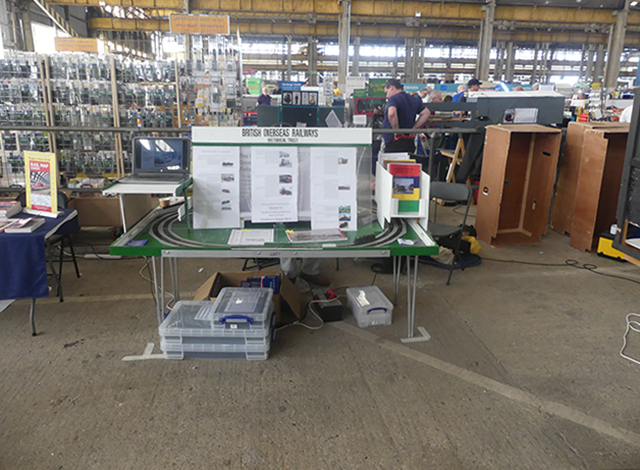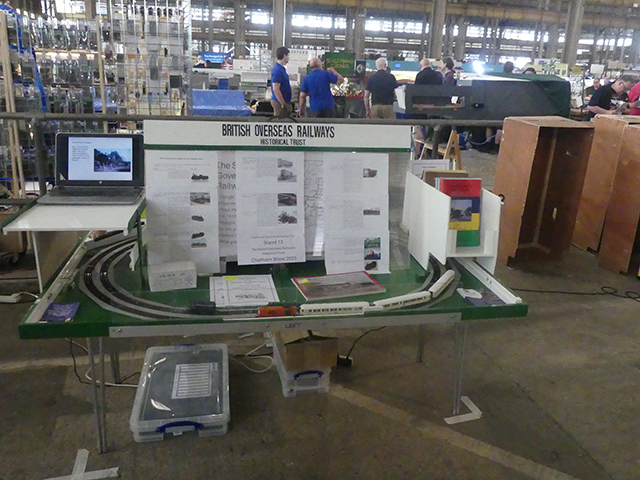THE BRITISH OVERSEAS RAILWAYS HISTORICAL TRUST
|  |
Chatham Show 2025 Report
 |
General setup of the BORHT stand at Chatham Dockyard.
Photo: © Julian Rainbow |
The Chatham Model Railway Show took place in the Slip No.5 of The Historic Dockyard over the weekend of 19th and 20th July 2025.
Although it was possible to set up on the Friday afternoon and evening, for our small stand it was as easy to arrive at about 07:15 hrs on the Saturday morning when it was still quiet and set up. I was able to drive up to the stand, unload and take my car out to the parking area within ten minutes. The walk back was about 10 minutes, and you can admire the various dockyard railway and marine exhibits on the way back without having to pay.
It was fairly quick to set up the stand and put out the sales items. I must thank Dick Waller who has built the display stand/layout who arrived by about 09:00 hrs. We completed the setting up helped by Geoff Warren who also volunteered to man the stand. Visitors began to arrive by 09:30 hrs and we were kept busy either operating the layout or talking to the visitors. Both Dick and Geoff had a long conversation about Tanzania with a visitor. Mostyn Lewis also arrived later to help out. There was time to walk around the show and admire the various layouts. Geoff had brought his OO Gauge EAR Class 81 Drewry Car Company diesel and rolling stock along and ran it around our layout with no-one commenting on the size discrepancy.
Possibly, because we have dual gauge track on both circuits, 16.5mm and 9mm on one and 16.5mm and 12mm on the other or we were running unfamiliar locomotives we were asked several times if it was OO gauge.
Mostyn and I found that Sunday was much a repeat, and I hope that we have managed to encourage a university student to visit the Greenwich office for research purposes later this year.
We made some sales, but most importantly spread the word about our charitable aims. I took special care to mention the research pages that Glyn Thomas was constructed for us.
4 p.m. on Sunday came soon enough, although taking the stores out of the Slipway was not as easy as getting them in, due to the large number of big layouts and traders wanting to get away. I definitely deserved a curry in the Gurkha Brothers, Whifflen Avenue Chatham that night. We hope to return to this show on the weekend of 18th and 19th July 2026. I would like to thank Dick, Geoff and Mostyn for their help in manning the stand. It is not a one-man task.
 | Closer view of the stand with models of a CP 1400 Class pulling the ESR Wagon-Lits stock and the VR F Class on the inner track. Photo: Julian Rainbow |
I list below that display cards we produced to inform visitors of what they might see.
What Locomotives might you see running today?
Great Britain exported a vast amount of railway material and knowledge around the world. Today we will show you just a bit of the export material.
Railway |
Locomotive |
Comboios de Portugal (CP) |
CP 110 Kitson and Co. Leeds, 1110/1863, |
Comboios de Portugal (CP) |
Série 1150 are small Sentinel shunting locomotives (with diesel-hydraulic engines built by Rolls-Royce) built in 1966-1967 for CP. Based on the "Steelman" locomotive used at industrial plants arounds the UK. Sentinel No. 1154 with a diesel-hydraulic engine built by Rolls-Royce in 1966/67 |
Comboios de Portugal (CP) |
Série 1400 designed by English Electric from 1967-69. The first ten were built in England at the Vulcan Foundry in Newton-le-Willows, with the remaining locomotives assembled in Portugal by Sorefame |
Egyptian State Railwys |
Wagon-Lit Salons built by Leeds Forge Company in 1929 |
Madrid, Zaragoza and Alicante Railway (MZA) Spain |
2-4-0T MZA 176-181, built by Sharp, Stewart of Manchester, 2708-2713/1877 |
Nationale Maatschappij der Belgische Spoorwegen, NMBS; Société nationale des chemins de fer belges, SNCB; |
Type 15, one of the John Farquharson McIntosh of the Caledonian Railway inspired designs. The Belgian State Railways (SNCB-NMBS) derived six series of steam locomotives (424 units) from the Dunalastair design between 1899 and 1913. The Type 15 was the same as Type 14, but with mid-deep firebox: 64.0 tons (built 1900–08, 73 units) |
Nationale Maatschappij der Belgische Spoorwegen, NMBS; Société nationale des chemins de fer belges, SNCB; |
Type 41 SNCB 41.198 Built by John Cockerill and hired by the War Office from the Belgian Government. At the time of hire it was Etat Belge 4298 and was renumbered in 1946. |
Nederlandse Spoorwegen (NS) |
No. 634, 0-6-0, 600 Series Diesel Electric Shunter. They were a class of 65 shunting locomotives built by English Electric in England between 1950 and 1957 for Nederlandse Spoorwegen (NS). The first 10 were built at Dick, Kerr & Co, Preston and the remaining 55 at Vulcan Foundry, Newton-le-Willows. T |
New South Wales Government Railway (NSWGR) Australia |
Pay bus. To replace the aging fleet of existing pay buses, six new pay buses were ordered from Commonwealth Engineering in 1967. These new pay buses had a longer and squarer body & were mounted on a 4-wheel chassis powered by an underfloor 6-cylinder Leyland model 0.400 horizontal diesel engine driving one axle via a Voith Diwabus model 501 fully automatic hydraulic/mechanical transmission & reversing gearbox. This then was coupled to a Voith E13 final drive on one of the axles. They had inward opening doors on both sides & a driving position at each end. The wheelbase of these pay buses was 18 ft 0 in (5.49 m), with a 30 ft 0 in (9.14 m) long body. These cars were also fitted with air conditioning. The front was taken from Commonwealth Engineering's standard bus model. FP7 entered service on 9 April 1968, with the last on 23 July 1968. FP11 is preserved on the Cooma Monaro Railway, NSW. In 1986 the operation of railway pay buses ceased with the last service being worked by FP 11 on 4 April 1986 between Lithgow and Clyde |
New South Wales Government Railway (NSWGR) Australia |
Sydney Suburban Parcels Van. The conveyance of parcels was a key service provided by NSWGR, and the Sydney metropolitan area was no exception. Parcel Vans were part of the Sydney rail scene for 60 years and provided a great service. All metropolitan railway stations were manned, so parcels could be dropped off and picked up from any station. The larger stations had goods sidings and a parcel office to handle the higher volume of parcels passing through them. A total of 17 self-powered parcel vans operated throughout the metropolitan area. The first three parcel vans were built by Clyde Engineering and Walsh Island Dockyard (Newcastle) between 1926 and 1929, most others were converted from single deck wood and steel body passenger cars as the need arose. |
New South Wales Government Railway (NSWGR) Australia |
The C30 class (formerly S.636 class) is a class of steam locomotives built by Beyer, Peacock & Company and Eveleigh Railway Workshops for the NSWGR. These 4-6-4 tank locomotives were specifically designed to haul Sydney's ever increasing suburban traffic, particularly over the heavy grades on the Northern, North Shore and Illawarra lines. The Beyer, Peacock & Company built the first batch of 35 which entered service in 1903/04. Subsequently, between 1905 and 1917, Beyer, Peacock built an additional 60 while the Eveleigh Railway Workshops of the NSWGR built 50 more (3066-3095, 3126-3145). |
New South Wales Government Railway (NSWGR) Australia |
The NSWGR Z19 class is a class of 0-6-0 steam locomotives operated by the NSWGR. By 1877, the main lines in New South Wales were nearing Tamworth, Wagga Wagga and Orange. The additional distances required an increase in motive power, especially as at that time, locomotives were changed after quite short journeys. They were only in service when manned by their regular crew Between 1877 and 1881, the initial order of 50 of these 0-6-0 wheel arrangement locomotives were delivered from Beyer, Peacock & Company. Between 1880 and 1891, Beyer, Peacock delivered a further nine, and Sydney manufacturer Henry Vale, 18. |
New South Wales Government Railway, (NSWGR) Australia |
The C30T class is an old class of steam locomotives rebuilt from 30 class tank engines by Clyde Engineering and Eveleigh Railway Workshops for the NSWGR. The first locomotive to be converted was Engine No. 3088 which was delivered by Clyde Engineering on 22 August 1928. |
South Australian Railways |
F255, 4-6-2T introduced from 1902 and built in SA. The F class hauled the majority of Adelaide's suburban passenger trains from its introduction in 1902. The first 22 were built by the Islington Railway Workshops. James Martin & Co built 12 units, with the remaining 10 built by Perry Engineering, the last entering service in October 1922 |
South Maitland Railways, New South Wales, Australia |
10 Class 2-8-2T, No. 10, built by Beyer, Peacock, 5520/1911, for East Greta Coal Company currently preserved by the Hunter Valley Training Co. |
Victoria Railways, Australia |
The Y class was an example of the new policy of standard design principles being adopted by the railways of the time. The original pattern locomotive (an 0-6-0 tender engine) was built by Kitson & Co. at Leeds in England in 1885, and was exhibited, along with E426, in 1888 at the Melbourne Centennial Exhibition, held in the Melbourne Exhibition Building. The other 30 locomotives of this type were built by the Phoenix Foundry at Ballarat in 1888–1889. They were given road numbers 383 to 441 (odd numbers only), and the pattern engine 445, 443 having been allotted to an "Old" R class. They were big locomotives for their time—in fact the largest and most powerful 0-6-0s to run in Australia. |
Victorian Railways, Australia |
F Class No. 202. The F Class were ordered by the Victorian Railways as part of Operation Phoenix, a £80 million program to rebuild a network badly run down by years of Depression-era underinvestment and wartime overutilisation. The Victorian Railways purchased ten 0-6-0DE diesel shunting locomotives in 1951 from English Electric. The locomotives were built at EE's Preston workshops in the United Kingdom, and entered service from October 1951 onwards. The design is similar to that of the standard-gauge British Rail Class 11 and Nederlandse Spoorwegen 600 class locomotives, which were also being built by EE at this time. No. 202 formerly F311, is allocated to the Seymour Railway Heritage Centre until deemed surplus 2017. It was used by SRHC as a shunting locomotive around their depot. It was then reallocated to 707 Operations and was again deemed surplus in 2023 awaiting disposal. |
RETURN TO Home Page Top of this Page